OPAL-RING
Yoichi HANEDA Laboratory
Research of sound, audio and acoustics signal processing for exciting communication.
| Faculty/Department | Department of Informatics Graduate School of Informatics and Engineering |
|---|---|
| Members | Yoichi Haneda, Professor |
| Affiliations | IEEE, Acoustical Society of Japan, Institute of Electronics, Information and Communication Engineers |
| Website | http://www.hanedalab.inf.uec.ac.jp/ |
As of August, 2015
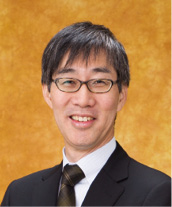
- Yoichi HANEDA
- Keyword
-
Sound, Acoustics, speech, Audio, Microphones, Loudspeakers, Directivity, Acoustic echoes, Digital signal processing
Previously researched echo cancelation and spatial propagation of sound
Professor Yoichi Haneda’s laboratory is quite new, having started full activities in the spring of 2013. The laboratory’s director, Professor Haneda, joined the University of Electro-Communications as a professor in October 2012. Previously, he has been with the NTT Media Intelligence Laboratory, NTT Corporation, where he researched audio and acoustic signal processing
His research interest is sound and acoustics signal processing, to the extent that the laboratory is dubbed the Sound Media laboratory. Professor Haneda’s research focus at the NTT Media Intelligence Laboratories was two areas broadly. One was an acoustic echo cancelation technology.
The sound systems of videoconferencing equipment or hands-free telephones consist of a microphone that picks up near-end speech and a far-end speech emmited from the loudspeaker in the same room. For example, when A (near-end) and B (far-end) have a conversation on the telephone, a B’s speech coming over A’s loudspeaker will be picked up by the microphone on A’s telephone. This part of B’s voice that is picked up by the microphone will be transmitted over the telephone line and come out of the loudspeaker at B’s end. When this happens, B hears his own slightly delayed speech, , through his telephone’s loudspeaker. This is an echo and is one factor that degrades telephone call quality.
Since NTT (Nippon Telegraph and Telephone) is a telephone service company as you know, Naturally for a phone company like NTT, the technology to eliminate or reduce echoes (echo cancelation technology) in order to keep the telephone quality is very important.
While at NTT, Professor Haneda was involved in developing technology to cancel echoes, but he also became interested in the nature of transmissions of the speech coming from the loudspeaker into the microphone. The characteristic of this transmission is influenced by the positions of the loudspeaker and microphone as well as the own reflections and refraction (resonance frequencies) of the room the phone is placed in. For example, because a room’s resonance frequencies are independent of the loudspeaker-microphone positions, if it is possible to characterize the room’s resonance frequencies in advance, then it could be possible to separate some acoustic echo components due to the far-end speech signal.
Acquisition only the desired sounds with a microphone array
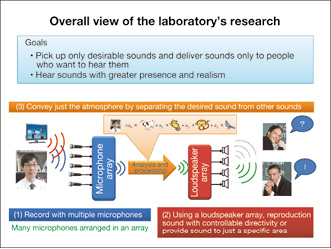
- Figure 1: An overall view of research area in Professor Haneda’s laboratory. The laboratory researches the recording of sound, the analysis and processing of sound, and the reproduction of sound.
Professor Haneda’s laboratory at the University of Electro-Communications is trying to further research into sound concerning with the communication. Sound research can be roughly classified into research into picking up sound (sound acquisition technology), research into analyzing and processing sound (information processing technology), and research into the reproduction of sound (sound field control technology). The laboratory’s goal, by mixing and matching these technologies, is to realize requirements where only the sounds you want are picked up, only the sounds you want are delivered, and acoustic spaces with excellent presence and realism are formed (see Figure 1).
First, sound acquisition technology is introduced. The members in Haneda’s laboratory are researching microphone arrays - i.e., arrangements of multiple microphones - in order to obtain only the desired sound signal. Microphone arrays normally place microphones on a line and obtain only the target speech by using the differences in sound incident direction, as seen from the microphone array, between the target sound source (the target speech) and noise sources. More specifically, these conventional arrays assume that the microphones input data from the target sound source and noise sources have no reflections and refractions.
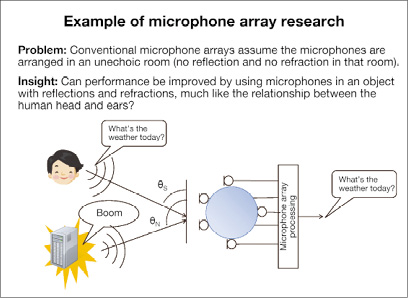
- Figure 2: An example of microphone array research. The microphone array is arranged on a sphere, resembling the human head, to capture sounds including reflections, refractions, and other information.
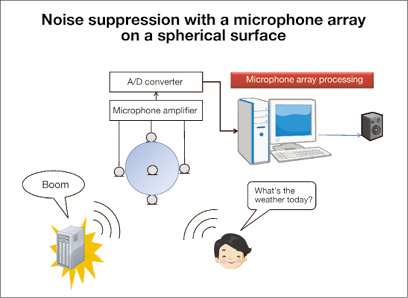
- Figure 3: Noise is suppressed by using the microphone input data includeingsound reflections, refractions, and other information, after converting the sounds to digital signals.
The laboratory is taking a different approach. By arranging the microphone array on the rigid structure that produces reflections or refractions, such like the human head, the reflected or refracted speech will also be picked up (see Figure 2). The use of digital signal processing to clean up the “noisy” speech signals recorded with the microphone array will improve the signal-to-noise ratio (see Figure 3).
It is difficlut for the conventional methods to separate the target speech from noise by using differences in the sound incident directions, if the noise source and the target source are aligned in the same direction. To overcome this problem, Professor Haneda’s laboratory is attempting to separate out noise using differences in distance to the microphone array between noise sources and the target source.
Dynamic control of loudspeaker directivity
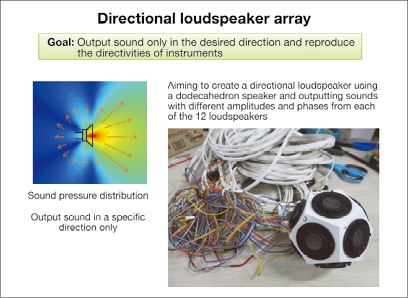
- Figure 4: Multiple loudspeakers are used to provide the arbitrary directivity. Loudspeaker drivers are mounted on each side of a dodecahedron. Sounds with different amplitudes and phases are output from each of the 12 loudspeaker drivers to control the directivity.
Next, let’s look at research into the reproduction of sounds. Professor Haneda’s laboratory is researching loudspeaker arrays - i.e., arrangements of multiple loudspeakers - to reproduce the desired sound field. The goal is to realize loudspeakers which can control the overall directivity of the sound. This is done by placing multiple loudspeaker drivers in a rigid sphere and outputting sound signals with different phases and amplitudes from each loudspeaker unit. The laboratory has built a prototype loudspeaker array with loudspeaker units set on each side of a dodecahedron that approximaites a sphere (see Figure 4).
The unique point about this loudspeaker array is that its directivity can be changed dynamically by adjusting the amplitude and phase of the sound coming out of each speaker unit in real time . The laboratory is exploring the possibilities for new sound expressions with the loudspeaker array by shifting the sound’s direction.
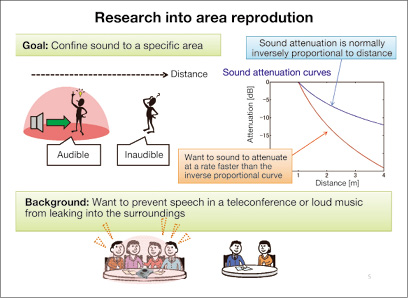
- Figure 5: Sound is only transmitted in a closed space without using physical walls or acoustic absorption curtain. The laboratory is experimenting with confining sound by placing speaker drivers in a ring and varying the amplitude and phase of sound coming from each driver.
The amplitude of sound normally decreases in inverse proportion with the distance from the sound source. In other words, speech will carry out to a certain distance. Professor Haneda’s laboratory is attempting to stop telephone conversations or music playback from leaking into the surroundings by confining sound to a fixed area (see Figure 5). Specifically, the laboratory is experimenting with playing voices back with an array of loudspeaker units arranged in a circle to control a sound field where the amplitude of sound attenuation rate much faster than the rate inversely proportional to the distance from the sound source.
Expanding the possibilities of sound recording
The development and widely use of the digital technology has profoundly changed the world of video and audio recording. Today anyone can easily take and enjoy photos and videos with a digital camera. It is quite common to edit and process photos on computers.
In the world of sound, although listening to and enjoying digital audio is commonplace, we do not enjoy the sound recording or sound processing easily like as video recording or processing. Professor Haneda believes much more research should be done into recording sounds with microphones. He says, for example, having a zoom function on microphones, like zoom lenses on cameras, would be an interesting and worthwhile endeavor.
It is difficult to see what lies ahead for this kind of added-value research into sound, and it is not a research topic corporations are very willing to take up. Therefore, the university is the proper home to this research area.
[Interview and article by Akira Fukuda (PR Center)]
